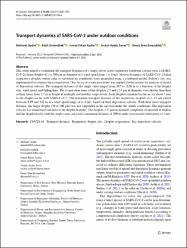Transport dynamics of SARS-CoV-2 under outdoor conditions

View/
Access
info:eu-repo/semantics/openAccessDate
2022Author
Aydın, MehmetEvrendilek, Fatih
Aydın, İsmail Erkan
Savaş, Seçkin Aydın
Evrendilek, Deniz Eren
Metadata
Show full item recordAbstract
This study aimed at estimating the transport dynamics of a single severe acute respiratory syndrome corona-virus 2 (SARSCoV-2)-laden droplet of 1 to 500 μm in diameter at a wind speed from 1 to 4 m/s. Motion dynamics of SARS-CoV-2-laden
respiratory droplets under calm or turbulent air conditions were quantifed using a combined model. Dalton’s law was
implemented to estimate their evaporation. One-factor-at-a-time procedure was applied for the sensitivity analysis of model
of deposition velocity. The transport distance of the single virus ranged from 167 to 1120 m as a function of the droplet
size, wind speed, and falling time. The evaporation times of the droplets≤3 and≤14 μm in diameter were shorter than their
settling times from 1.7 m in height at midnight and midday, respectively. Such droplets remained in the air for about 5 min
as the droplet nuclei with SARS-CoV-2. The minimum transport distance of the respiratory droplets of 1–15 μm varied
between 8.99 and 142 m at a wind speed range of 1–4 m/s, based on their deposition velocity. With their short transport
distance, the larger droplet (30 to 500 μm) was not suspended in the air even under the windy conditions. The deposition
velocity was found most sensitive to the droplet diameter. The droplets<15 μm in diameter completely evaporated at midday
and the droplet nuclei with the single virus can travel a minimum distance of 500 m under a horizontal wind speed of 3 m/s.
Source
Air Quality Atmosphere and HealthVolume
15Issue
5URI
https://hdl.handle.net/20.500.12868/1527https://link.springer.com/article/10.1007/s11869-022-01196-x

















